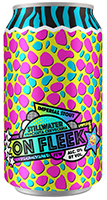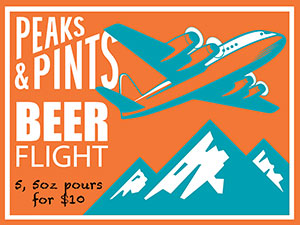 Consider the vanilla bean. The Aztecs did. In addition to inventing long words ending in “atl” and awesome mythology, they had the patience to figure out how to cultivate vanilla — a particularly difficult flavor to come by. The pods are the fruit of an orchid plant (Vanilla planifolia), and they have to be cured and fermented over the course of about six months. If that weren’t involved enough, the high-maintenance orchid itself has to be pollinated by hand. Mexico continues to be a major producer, but bourbon vanilla pods from Madagascar are considered to be the Chanel No. 5 of vanilla, valued for its rich depth of flavor. For many years now, vanilla has been the adjunct that takes a beer’s status from gold to platinum. Not wanting to waste a drop we present Craft Beer Crosscut 11.3.17: A Flight of Vanilla Bean.
Consider the vanilla bean. The Aztecs did. In addition to inventing long words ending in “atl” and awesome mythology, they had the patience to figure out how to cultivate vanilla — a particularly difficult flavor to come by. The pods are the fruit of an orchid plant (Vanilla planifolia), and they have to be cured and fermented over the course of about six months. If that weren’t involved enough, the high-maintenance orchid itself has to be pollinated by hand. Mexico continues to be a major producer, but bourbon vanilla pods from Madagascar are considered to be the Chanel No. 5 of vanilla, valued for its rich depth of flavor. For many years now, vanilla has been the adjunct that takes a beer’s status from gold to platinum. Not wanting to waste a drop we present Craft Beer Crosscut 11.3.17: A Flight of Vanilla Bean.
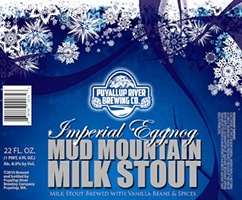 Puyallup River Imperial Eggnog Mud Mountain Milk Stout
Puyallup River Imperial Eggnog Mud Mountain Milk Stout
8.5% ABV, 20 IBU
Puyallup River Brewing Mud Mountain Milk Stout grabbed a silver medal at the 2015 Washington Beers Awards. It grabbed a bronze at the 2016 Washington Beer Awards. It grabs every drinker when they taste its smooth as chocolate silk self. Fresh vanilla beans, cocoa nibs, oats, and six different specialty malts, including Chocolate malt, make this milk stout one of the easiest drinking dark beers on the planet. Add cinnamon, nutmeg and other holiday spices and you have Imperial Eggnog Mud Mountain Milk Stout, with creamy flavors of eggnog, spice, coffee, roasted nuts and chocolate. Ends smooth and creamy.
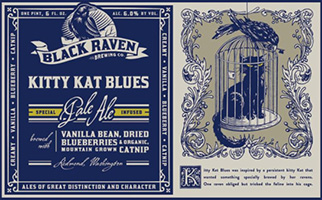 Black Raven Kitty Kat Blues
Black Raven Kitty Kat Blues
5.8% ABV, 35 IBU
From Redmond, comes this Black Raven Brewing unassuming pale ale that has the screws turned a bit with additions of dried blueberries, vanilla bean and organic mountain-grown catnip. The result is an easy drinking pale ale that finishes like this morning’s blueberry muffin with, of course, vanilla, dry bittering hops and heard catnip, which is similar to hops in taste — in fact they are a relative, but the flavor is very dry, medium bitterness, drying in the mouthfeel.
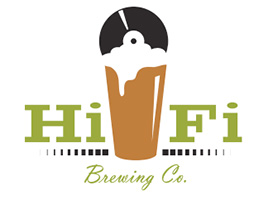 Hi-Fi Brewing Whiskey Vanilla Woofer Porter
Hi-Fi Brewing Whiskey Vanilla Woofer Porter
6.9% ABV, 40 IBU
Hi-Fi Brewing rocks its Woofer Porter with Carafa II malt provides the roasty, almost coffee-like flavor, while a variety of caramel malts contribute sweetness. After the Redmond, Washington brewery infuses Woofer with liberal infusions of whiskey and vanilla post-fermentation the result is an aroma of vanilla bean, roast, wood and bourbon with flavor following suit with also chocolate and slight booze.
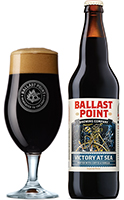 Ballast Point Victory At Sea
Ballast Point Victory At Sea
10% ABV
Victory at Sea’s story begins in 1992, when a homebrewer named Jack White, recognizing the dearth of good supply shops nearby with which to augment his hobby, opened Home Brew Mart near Mission Beach in San Diego. Another homebrewer, Yuseff Cherney, soon joined him, and together the two moved the brews they were making in their back yards to the back of the shop. In 1996, Ballast Point was born. Victory at Sea smells like breakfast — Aromas of cappuccino gelato and medium-roast coffee with milk meld with subtle background vanilla notes as well as bits of sourdough and brown sugar. In the flavor, Victory at Sea switches to dessert. Bitter medium-roast coffee flavors play at the sides of the tongue while chocolate, vanilla and caramel build at the front. Toast and molasses make appearances as well, and alcohol heat rolls down the throat, noticeable but not overpowering.
13% ABV, 50 IBU
Vermont brewery Casita Cerveceria traveled to Baltimore, Maryland to brew this black as night imperial stout at Stillwater Artisanal. Oh, but it doesn’t smell like motor oil but instead coffee, burnt toast, dark chocolate and a little marshmallow, all woven between strong alcohol tones. We placed this delicious treat at the end of the flight as it warms complex licorice, bold earthy bitterness, chocolate, earthy vanilla, faint smoke and caramel fudge come forth. It finishes long with an intense and heavy mouthfeel — almost like a milkshake — slightly vinous for the style, with a smooth but firm alcohol warmth. There’s enough carbonation to push the beer along and make it dangerously, DANGEROUSLY drinkable for 13 percent.
